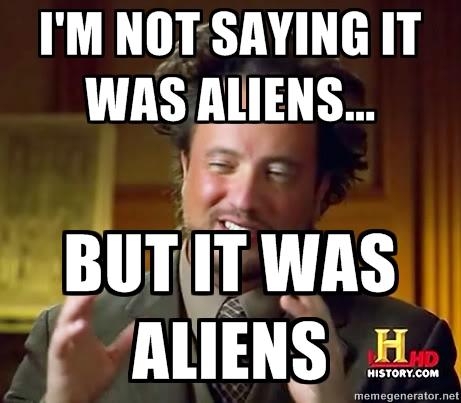- Joined
- 25 June 2009
- Messages
- 14,753
- Reaction score
- 6,144
There is a generalized impression that Burt Rutan, the man behind some of the most uncanny aircraft of the last 40 years, is a staunch believer in alien visitors.
According to a preface he wrote for John Alexander's UFOs: Myths, Conspiracies, and Realities, this is just NOT true.
Here are a few chosen bits which clearly show this:
Not exactly the words of a space alien freak, right? So why do so many people think he is? Rutan claims that his friend Dan Kreigh is partly responsible:
He also admits to some personal friends that have spoken on the subject before and admits this may have caused a confusion.
So, if the case is settled, you may well wonder why I added the part into parentheses in this topic's title: "well, sort of." That's because Rutan DOES report of his own experience of seeing a UFO once.
Then later he develops:
So, all in all, does he or doesn't he believe in alien visitors? Let's see his own conclusion:
That kind of puts things in perspective. And kills the old myth of the E.T. lover.
(That is, unless the last paragraph is a clever disinformation trick, of course.)
Entire document (in which you will also learn about Rutan's other hobbies, some quite astonishing) can be found here:
http://www.burtrutan.com/burtrutan/downloads/RutanIntroToJohnAxexanderUFOBook.pdf
According to a preface he wrote for John Alexander's UFOs: Myths, Conspiracies, and Realities, this is just NOT true.
Here are a few chosen bits which clearly show this:
I have always found it difficult to read any book on UFOs. They all seemed to be written only by those strongly advocating their chosen side of the debate of the big question “Do ETs exist?”. These books would be compelling if there were convincing physical evidence to inspect (hardware, bodies, wreckage, etc). However my impression usually is that there is no compelling evidence and the author’s credible data could be summarized into a few pages. However, they then seem content to drag the reader through hoards of speculation and rhetoric for no useful purpose.
John has rightly described me as a skeptic. This is a refreshing truth, especially after Wired magazine had reported, “Burt Rutan thinks Extraterrestrial Aliens built the Gaza Pyramids”. During a long interview for their magazine on a different subject I included my thoughts from my study of the Egyptian monuments. I mentioned my conclusion
that several of the structures had clear evidence of manufacturing technologies well beyond what the mainstream historian’s assume existed at the time. This is a fascinating subject indeed, but it has nothing to do with ET aliens. For me, it is far easier to believe that the ancients had developed methods to cast or machine granite and that these methods were later forgotten, than to believe that starships had visited earth to help humans stack stones.
Not exactly the words of a space alien freak, right? So why do so many people think he is? Rutan claims that his friend Dan Kreigh is partly responsible:
My use of a Men In Black Neuralizer on the audience at one of my Oshkosh/Air-Venture talks in 1997 led some people to think I am an ET/UFO-believer. Engineering cohort Dan Kreigh, using a toothbrush case and the components of a flash camera, built the device. Yes, it was only a joke; humor is needed when you work in the High Desert. Dan was also the one who painted an alien face on a back window of my Boomerang twin aircraft.
He also admits to some personal friends that have spoken on the subject before and admits this may have caused a confusion.
So, if the case is settled, you may well wonder why I added the part into parentheses in this topic's title: "well, sort of." That's because Rutan DOES report of his own experience of seeing a UFO once.
Even though I have seen a flying object that I could not identify, I have never made it a hobby to study UFOs.
Then later he develops:
The following is the first-ever publication of my 1972 sighting. It occurred while I was driving northbound on I-135 in Kansas by myself in the dark, pre-dawn hours of May 31st, 1972. I was on my way to direct the first flight test of the BD-5 when off to the right I noticed a brilliant, hovering, cylinder-shaped object with a length about 4 or 5 times its diameter. Assuming it was not moving, it was easy to determine its distance from me by knowing my car’s speed and observing the angular rate at which my line of sight rotated from the center windshield to the right side window. I slowed to stop on the side of the road and when I had stopped the object quickly accelerated to the south and disappeared within about two seconds. I estimate that it was about 300 to 400 meters away and its size was about 30 to 50 meters long. It had been hovering at about 10 to 20 meters above the ground.
It did not appear to have a solid surface; it was more like a fuzzy fluff of glowing light with no distinct surface details. During the ~ 15 seconds that it was visible, it changed colors at least twice; green, orange, yellow as I recall. I took note of my car’s odometer so I could find the site again. When I returned in daylight I found highvoltage electric transmission lines crossing a small lake near the spot where it had been hovering. I therefore formed an opinion that the “object” might have been some electrical ion phenomena. However, I was intrigued to later read about a sighting of a object with similar appearance in Louisiana. You can go to the approximate location of my “hovering UFO” using Google Earth at Lat 37.9230, Long -97.3243.
So, all in all, does he or doesn't he believe in alien visitors? Let's see his own conclusion:
A reason that I remain an ET skeptic is that, for 45 years I have been in a position to handle sensitive technical information and have not heard of anything related to ET hardware or reverse-engineering projects. I have served two separate 5-year terms on the US Air Force Scientific Advisory Board, including a study group assigned to evaluate research for advanced propulsion systems (at Wright-Patterson AFB, the Air Force Research Laboratory Propulsion Directorate and other locations), but I have never heard anyone mention the kind of stuff that excites the ET/UFO crowd. I only hear those wild claims from people that promote the lore, but never from any Government official or other credible source.
That kind of puts things in perspective. And kills the old myth of the E.T. lover.
(That is, unless the last paragraph is a clever disinformation trick, of course.)
Entire document (in which you will also learn about Rutan's other hobbies, some quite astonishing) can be found here:
http://www.burtrutan.com/burtrutan/downloads/RutanIntroToJohnAxexanderUFOBook.pdf


